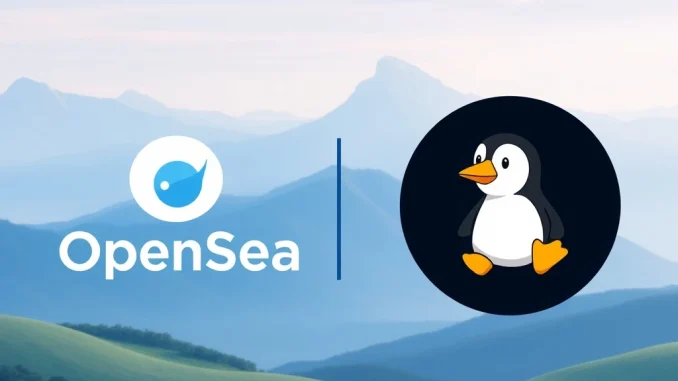
In the ever-evolving world of digital assets and brand identity, a subtle change can often signal a larger strategic move. Recently, the OpenSea NFT marketplace made headlines by updating its profile picture on the social media platform X (formerly Twitter) to feature a distinctive Pudgy Penguins non-fungible token (NFT). This move isn’t just a simple aesthetic choice; it reflects a growing trend of major crypto and Web3 brands using popular NFT collections as a form of digital signaling and Crypto Marketing.
Why Are Brands Embracing Pudgy Penguins?
The decision by OpenSea to adopt a Pudgy Penguin as its public face on a major social platform follows a similar action taken earlier by Coinbase, another significant player in the crypto space. This raises the question: why Pudgy Penguins?
Pudgy Penguins have emerged as one of the most recognizable and beloved NFT collections since their launch. Beyond the digital collectibles themselves, the brand has successfully expanded into mainstream merchandise, including physical plush toys sold in major retail stores. This expansion has given the collection a level of brand recognition and appeal that extends beyond the typical crypto-native audience. By aligning with Pudgy Penguins, brands like OpenSea and Coinbase tap into:
- Community Goodwill: The Pudgy Penguins community is known for being engaged and positive. Adopting the PFP is a nod to this community.
- Mainstream Recognition: The physical products have introduced the brand to a wider audience.
- Symbol of Resilience: Pudgy Penguins navigated early challenges and emerged stronger, symbolizing resilience in the volatile NFT market.
- Playful & Approachable Image: The characters themselves are inherently friendly and approachable, potentially softening a brand’s image.
OpenSea and the Strategy Behind the Pudgy Penguins PFP
For OpenSea, changing its profile picture to a Pudgy Penguin is more than just following a trend initiated by Coinbase. It’s a strategic alignment. As a leading NFT marketplace, OpenSea’s identity is intrinsically linked to the success and visibility of the NFT collections it hosts. By featuring a prominent collection like Pudgy Penguins, OpenSea signals:
- Commitment to the NFT Ecosystem: It reinforces OpenSea’s core business and its belief in the longevity of the NFT market.
- Support for a Successful Collection: Highlighting Pudgy Penguins shows support for one of the most successful and enduring collections on its platform.
- Brand Positioning: It positions OpenSea alongside other major players (like Coinbase) who are also embracing this form of digital identity.
- Community Engagement: It’s a way to engage directly with the passionate Pudgy Penguins community and potentially attract their users to the platform.
This form of Brand Adoption of specific NFT collections represents a new frontier in Crypto Marketing. Instead of traditional advertising, companies use their own brand identity to showcase and endorse specific digital assets, leveraging the cultural capital and community built around those assets.
What Does This Mean for NFT Holders and the Market?
The adoption of NFT PFPs by major brands has several implications:
- Increased Visibility for Collections: When a major brand uses an NFT from a collection, it provides massive visibility to that collection.
- Validation for the NFT Space: It serves as validation that NFTs are not just speculative assets but can also function as meaningful brand symbols and cultural icons.
- Potential for Future Collaborations: These moves could foreshadow deeper collaborations between brands and NFT projects.
- Shifting Marketing Landscape: It highlights a shift towards community-centric and digitally-native marketing strategies in the Web3 space.
While this trend is positive for the visibility and perception of NFTs, it’s also important to consider the challenges. The value and perception of NFT collections can be volatile, and associating a brand too closely with a single collection carries some risk. However, aligning with a collection like Pudgy Penguins, which has demonstrated resilience and mainstream appeal, mitigates some of that risk.
Is This the Future of Brand Identity in Web3?
The actions of OpenSea and Coinbase suggest that using popular NFT collections as brand avatars could become a standard practice for companies operating in or targeting the Web3 space. This form of Brand Adoption is authentic to the culture of Web3, where PFPs are a fundamental part of online identity.
It’s an interesting evolution of Crypto Marketing, moving beyond simple advertisements to integrated identity signaling. As more brands explore how to represent themselves in decentralized digital environments, expect to see further innovation in how they use NFTs and other digital assets.
Conclusion: A Strategic Penguin Move
OpenSea’s decision to feature a Pudgy Penguins NFT as its X profile picture is a calculated move that aligns the marketplace with a successful, recognizable, and community-backed collection. Following Coinbase’s lead, it underscores the growing importance of NFT collections as tools for Brand Adoption and Crypto Marketing in the digital age. This isn’t just a profile picture change; it’s a clear signal of OpenSea’s commitment to the NFT ecosystem and an embrace of Web3 native identity, potentially paving the way for further integration of popular digital assets into corporate branding strategies.



